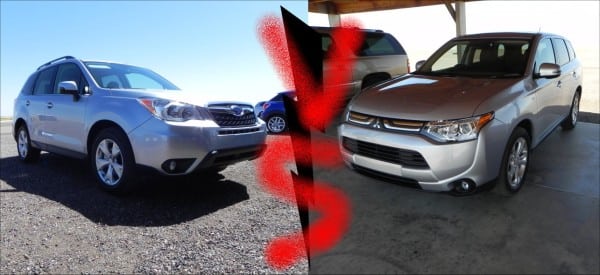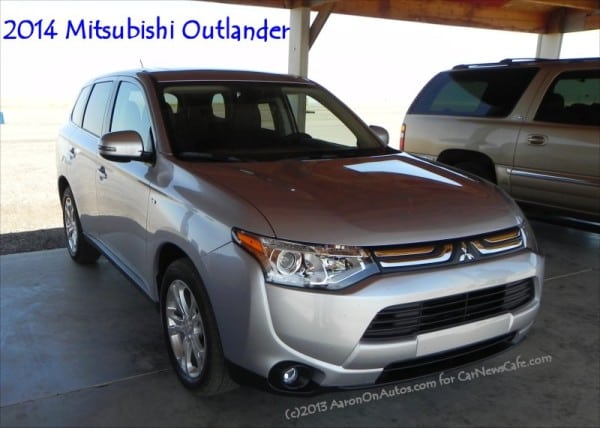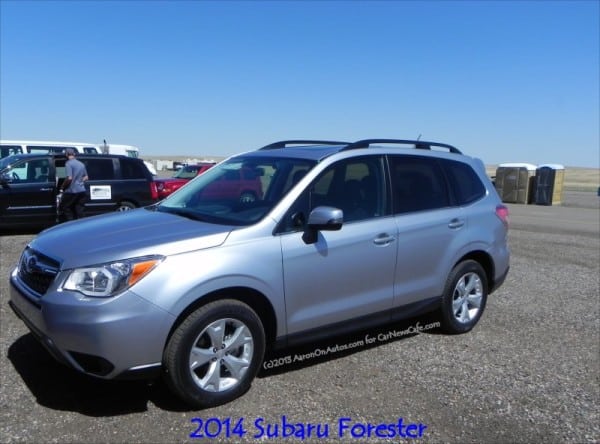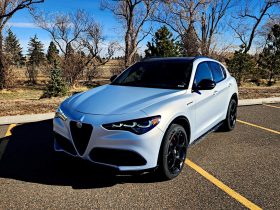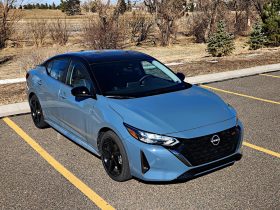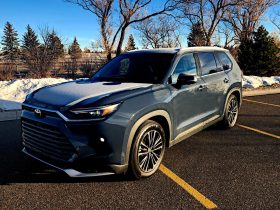At a recent automotive event, CarNewsCafe had a unique opportunity to drive two vehicles that directly compete on the market, hold roughly the same market share, have both undergone stem-to-stern improvements for the new year, and to do our testing on exactly the same roads with the same driver at about the same time of day. It doesn’t get any more perfect than that without putting on a white lab coat and adding a lot of expensive test equipment to the mix, which would have ruined the driving experience for us anyway because, well, we’re journalists, not scientists.
The cars were the 2014 Mitsubishi Outlander and the 2014 Subaru Forester. The location was just outside of Denver, Colorado in a rural location that included highway, dirt track, and parking lot situations. Total time in each car, not including photo taking and peering under the hood, was about 45 minutes per vehicle. In both cases, we had a ride along passenger who was a manufacturer’s rep to show us all of the improvements for the 2014 model year upgrade.
We’ll save the full features list and so forth for individual vehicle reviews and concentrate today on how the two stack up against one another in drive, versatility, and ergonomics.
Overview of the 2014 Outlander
For 2014, Mitsubishi made a lot of improvements to the Outlander, a sport utility that, frankly, needed a lot of work. Compared to last year’s model, the 2014 Outlander is a completely different vehicle. It retains Mitsubishi’s sporty qualities, but finally replaces the cheap plastic and horrible interior layout it once had with a refreshed, far more user-friendly and higher quality interior.
The body style on the 2014 Outlander is also much improved. It’s far more modern and very well designed. A third row, suitable for children and young adults, adds to the SUV’s versatility and the cargo space is more than ample. The premium stereo adds a sub-woofer to the rear cargo area, but puts it against the left sidewall instead of the center, where last year’s model had it hogging up valuable space.
Little, detailed improvements like that have taken the Outlander from a market loser to at least par for this competitive segment. Mitsubishi should fare much better, in terms of sales volumes, because of these updates.
Overview of the 2014 Forester
The Forester was already hitting its market niche well, though frankly that niche is relatively limited. Subaru has a strong following and the 2014 Forester caters to them in a big way. Styling has been improved to match Subaru’s line of crossovers and sport wagons and the signature boxer engine still putters under the hood to deliver plenty of go-power.
Most of the improvements for the 2014 model year were not in exterior design, however, they are in usability and ergonomics. The 2014 Forester’s doors are taller and a bit wider. Driver controls are more attenuated to daily use, though this is something Subaru has long excelled at. Seating is noticeably more comfortable, though, and an easier “one hand” rear seat folding mechanism makes dropping the rear seats to expand the cargo space a much faster and easier operation.
Other, more subtle improvements include better visibility for the driver, improved aerodynamics, and small interior touches to add storage and accessibility.
Exterior Styling Comparison
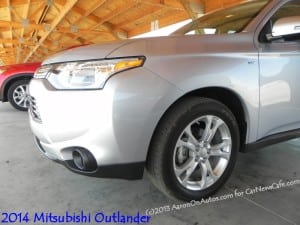 Sitting side-by-side, the 2014 Subaru Forester still has its Sub looks and feel, though most of the boxiness is (thankfully) gone. The 2014 Mitsubishi Outlander, though, is far more refined in its aesthetics and definitely wins the game in overall style points.
Sitting side-by-side, the 2014 Subaru Forester still has its Sub looks and feel, though most of the boxiness is (thankfully) gone. The 2014 Mitsubishi Outlander, though, is far more refined in its aesthetics and definitely wins the game in overall style points.
The Forester just gives the impression that it really wishes it was a smaller wagon instead of a crossover SUV while the Outlander makes it clear that it knows what it is and isn’t ashamed of that.
In details, the Outlander has a beautiful grille, a broad-shouldered, but not muscular front end, and a strong-looking stance that says it’s tough, but not so mean that it can’t be trusted with the kids.
Interior Styling and Ergonomics Comparison
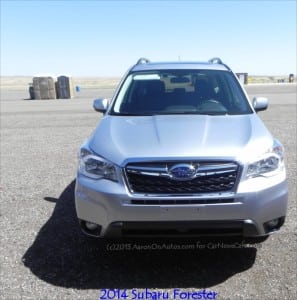 Despite the vast improvement in ergonomics for the Outlander, the 2014 Forester is a much more user-friendly vehicle. Owners will appreciate the wider, taller doors, the removal of the sills that so often seem to catch feet and snag grocery sacks, and the cargo-ready floor of the rear space, even with the seats folded. Getting in and out of the Subaru is just easier.
Despite the vast improvement in ergonomics for the Outlander, the 2014 Forester is a much more user-friendly vehicle. Owners will appreciate the wider, taller doors, the removal of the sills that so often seem to catch feet and snag grocery sacks, and the cargo-ready floor of the rear space, even with the seats folded. Getting in and out of the Subaru is just easier.
The Outlander, however, has that third row, slightly more interior space, and a far softer door close than the Subaru. In fact, in that last regard, the Subaru is more like a truck, requiring you to forcefully close the doors versus the Outlander’s more car-like “click” to shut.
Overall, though, the 2014 Forester is much more stylish and user friendly inside and takes the win in this category.
Cargo Space Comparison
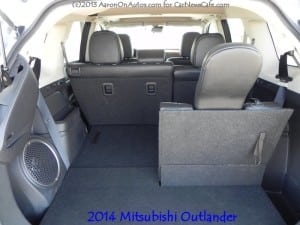 Cargo space in both vehicles is very close to identical in terms of space and access. The Subaru has no third row, so accessing the expanded cargo space is easier, and its lack of a lip at the rear hatch makes it far easier to slide items in and out of. Both models offer a plastic, spill-proof floor pan option that is highly recommended if you’re the outdoorsy type, especially in the rear cargo space.
Cargo space in both vehicles is very close to identical in terms of space and access. The Subaru has no third row, so accessing the expanded cargo space is easier, and its lack of a lip at the rear hatch makes it far easier to slide items in and out of. Both models offer a plastic, spill-proof floor pan option that is highly recommended if you’re the outdoorsy type, especially in the rear cargo space.
In overall cargo usage, though, the two come up as a tie. While the Subaru has slightly better ergonomics, the Outlander has a more square storage area, making it slightly more versatile.
Outlander vs. Forester On the Road
On the road, the 2014 Subaru Forester and the 2014 Mitsubishi Outlander are two very different vehicles. The Subaru is a.. well, Subaru. It rides well and gives a lot of feedback to the driver. The Outlander shows a lot of improvement in driveability, retaining the sporty feel and powerful get-up-and-go that Mitsu is known for, but with a much more refined ride than it had previously.
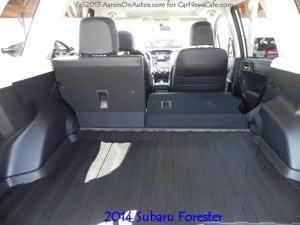 Noise levels in the two are about the same, though the Subaru is slightly quieter – likely due to its more car-like exterior design. Acceleration and braking are roughly equivalent in both utes and offroad prowess is basically the same in both as well.
Noise levels in the two are about the same, though the Subaru is slightly quieter – likely due to its more car-like exterior design. Acceleration and braking are roughly equivalent in both utes and offroad prowess is basically the same in both as well.
Where the Outlander shines, though, is in its comfort level. Despite the generally nicer interior of the Subaru, the 2014 Outlander has a nicer feel to its overall experience on the road. The seats are a touch softer, the suspension is a far cry from the rough-and-tumble butt-shaker it had last year, and the overall driving experience is just smoother.
On the road, the Mitsubishi definitely takes the win compared to the rougher Subaru.
Verdict Overall
The win goes to the 2014 Mitsubishi Outlander, though the battle was very close. The Outlander wins by one, which probably isn’t enough to win over any Subaru fans, but it is enough to show that Mitsubishi has definitely come out swinging in their renewed efforts to gain more inroads into the American market.




